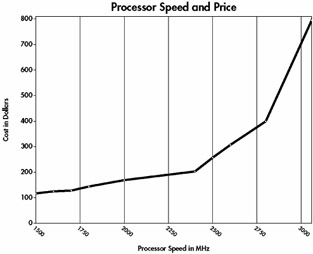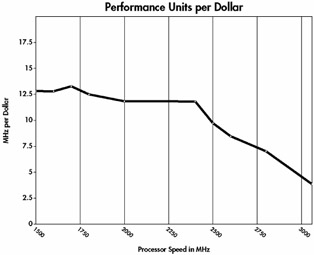17.4 Saving Money
17.4 Saving Money
Axiom 3 in the introduction to this chapter stated that you often get what you pay for; in other words, you might need to pay for a system that works and works well. However, there's no injunction against saving money. If you don't have an obsession with the very latest products, and you know what to look for, you can look for slightly older stuff and save a substantial sum.
17.4.1 CPU
Although it is true that your CPU does most of the work on a Linux system, the CPU normally spends most of its time doing absolutely nothing. The uptime command usually reveals that the processor isn't running any jobs. If processor speed is important to you, you'll know it from the type of computing that you do, be it graphics or numerical analysis. But for the vast majority of users, there are many features more important than CPU speed, and carefully choosing a processor is one of the best ways to save money on a new computer.
Nowhere does price so wildly diverge as among processors. A vendor's list at the time of this writing shows one price for its fastest CPU. The next step down is 50 percent of that price, but it is still 91.5 percent as fast as the top model. A slower processor costing 25 percent of the top model retains 78 percent of the performance. Now you may ask yourself, maybe I need that extra 22 percent of power? For comparison, I am typing this on a computer that is only 12 percent as fast as the top processor in that list, and I have no complaints.
The trick to selecting a processor is to pick a spot on the performance/price curve that looks good. Figures 17-1 and 17-2 show plots of ten processors. Figure 17-1 shows how quickly the price rises as the processor speed reaches the fastest available. In Figure 17-2 on the next page, you can see how much performance you get for each dollar that you spend for the same set of processors.

Figure 17-1: Costs of several processors.

Figure 17-2: Performance value.
If you are strictly interested in getting the most bang for the buck, the best choice is the CPU represented by the maximum in the graph on the right. However, keep in mind that you may want to go for one of the CPUs with slightly faster numbers because it may cost only a few dollars more, or you might be able to buy a CD or something else with the savings from choosing a marginally slower option.
You must be cautious in measuring the performance of a processor. The only halfway precise way to compare processors is to compare different clock speeds of the same model . Looking at the megahertz (MHz) numbers of two different models, even from the same manufacturer, is comparing apples and oranges. The benchmark results you read about are also unreliable because operation speeds vary among different processors. Unless you know exactly what you're looking for, benchmarks are next to useless. Decide on a price first, and then look for the best deals among the models that fall within your price range.
If you find any of this economic analysis remotely interesting, you might want to read the first chapter of Computer Architecture: A Quantitative Approach [Hennessey].
17.4.2 Hard Disk
More expensive hard disks often provide more space for the money. For example, a certain hard disk may offer 100 percent more space over another model for only 33 percent more money. But if you're running Linux, which is an operating system with relatively low system storage requirements, is "supersizing" really worth it? Considering how much a modern hard disk can store, will you actually use that extra space before you buy another disk?
By the time you need to purchase another disk, you may find that the cost per megabyte on a new disk is far lower, or that there are desirable technology improvements that may just make you want to decommission your old disk. Remember that the hard disk still has moving parts , and it is therefore one of the least reliable components in a computer.
17.4.3 Computer Case
Ugly cases with unrefined power supplies and unsophisticated internal structures are cheaper. If you're not picky and can put up with the hassle, this could be worth it (that is, you're a graduate student and know what it means to have something "cheap but somewhat functional if not kind of annoying"). Also, you might be able to get a used case for free. Be careful, though: a secondhand power supply may not work with your motherboard, and it may not work at all.
17.4.4 Video Card
Sometimes you can get a graphics card that the vendor targets for office users. These cards are often less expensive than others. Also, old or discontinued models on clearance won't hurt performance on Linux.
EAN: 2147483647
Pages: 189